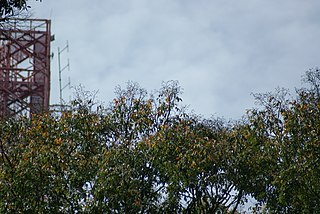
Aquilaria is a genus of fifteen species of trees, called lign aloes or lign-aloes trees, in the Thymelaeaceae, native to southeast Asia. They occur particularly in the rainforests of Indonesia, Thailand, Cambodia, Laos, Vietnam, Malaysia, Northeastern India, Bangladesh, the Philippines, Borneo and New Guinea. The trees grow to 6–20 m tall. The leaves are alternate, 5–11 cm long and 2–4 cm broad, with a short acuminate apex and an entire margin. The flowers are yellowish-green, produced in an umbel; the fruit is a woody capsule 2.5–3 cm long.

Koompassia malaccensis is a tropical rainforest tree species up to 60 m tall in the Fabaceae family. It is native to Peninsular Malaysia, Singapore, Borneo and Thailand. It is threatened by habitat loss. A common name for this wood is Kempas, it is used as a flooring material.

The streaked bulbul, or green-backed bulbul, is a songbird species in the bulbul family (Pycnonotidae). It is found on the Malay Peninsula, Sumatra, and Borneo. Its natural habitat is subtropical or tropical moist lowland forests. It is becoming rare due to habitat loss.

Actinodaphne malaccensis is a species of tree in the laurel family, Lauraceae. It is native to Malaysia and Singapore. It is used for timber.

Aquilaria malaccensis is a species of plant in the Thymelaeaceae family. It is found in Bangladesh, Bhutan, India, Indonesia, Laos, Malaysia, Myanmar, the Philippines, Singapore, and Thailand. It is threatened by habitat loss.

40 chansons d'or is a double-CD by Charles Aznavour, released in 1994 on EMI Records. It was reissued in 1996 with a different track listing.
Malaccensis may refer to:
"The Old Fashioned Way" is the English version of Charles Aznavour's Les plaisirs démodés song. The song was released in 1973 by Barclay Records as a single and became a hit in the Netherlands (#5), Belgium and in the UK.
L. malaccensis may refer to:
Madhuca malaccensis is a plant in the family Sapotaceae. It grows as a tree up to 25 metres (82 ft) tall, with a trunk diameter of up to 45 centimetres (18 in). The bark is greyish brown. Inflorescences bear up to eight flowers. The fruits are oblong, up to 2.7 centimetres (1.1 in) long. The tree is named after Malacca in Peninsular Malaysia. Habitat is lowland mixed dipterocarp forest from sea-level to 50 metres (160 ft) altitude. M. malaccensis is found in Thailand, Sumatra, Peninsular Malaysia, Singapore and Borneo.
Pouteria malaccensis is a tree in the family Sapotaceae. It grows up to 30 metres (100 ft) tall with a trunk diameter of up to 70 centimetres (30 in). The flowers are greenish-white and fragrant. The fruits are ellipsoid to roundish, up to 3.8 cm (1 in) long. The tree is named after Malacca in Peninsular Malaysia. The timber is used locally in furniture-making. Habitat is forests from sea-level to 1,400 metres (4,600 ft) altitude. P. malaccensis is found in Thailand, Sumatra, Peninsular Malaysia, Borneo, Sulawesi and New Guinea.

Mesosini is a tribe of longhorn beetles of the Lamiinae subfamily.
Demodes is a genus of longhorn beetles of the subfamily Lamiinae, containing the following species:
Demodes bimaculata is a species of beetle in the family Cerambycidae. It was described by Stephan von Breuning in 1947. It is known from Laos.
Demodes javanica is a species of beetle in the family Cerambycidae. It was described by Stephan von Breuning in 1950.
Demodes mindanaonis is a species of beetle in the family Cerambycidae. It was described by Stephan von Breuning in 1939.
Demodes siporensis is a species of beetle in the family Cerambycidae. It was described by Stephan von Breuning in 1939.
Demodes subconspersa is a species of beetle in the family Cerambycidae. It was described by Stephan von Breuning in 1950. It is known from Borneo.
Demodes conspersa is a species of beetle in the family Cerambycidae. It was described by Per Olof Christopher Aurivillius in 1914 and is known from Borneo.
Demodes frenata is a species of beetle in the family Cerambycidae. It was described by Francis Polkinghorne Pascoe in 1857, originally under the genus Apomecyna. It is known from Singapore, Malaysia, and Sumatra.








